
漢德百科全書 | 汉德百科全书
 UEFA European Championship 2020
UEFA European Championship 2020

Veranstaltungen Leichtathletik: Olympische Sommerspiele 1960 Europameisterschaften 1974 Golden Gala (seit 1980, Diamond League) Weltmeisterschaften 1987 Europameisterschaften 2024 Fußball: Fußball-Europameisterschaft 1968 Weltpokal 1973 Fußball-Europameisterschaft 1980 Finale Europapokal der Landesmeister 1976/77 Finale Europapokal der Landesmeister 1983/84 Fußball-Weltmeisterschaft 1990 Finale UEFA Champions League 1995/96 Clericus Cup (seit 2007) Finale Coppa Italia (seit 2008) Finale UEFA Champions League 2008/09 Fußball-Europameisterschaft 2021 Rugby: Six Nations (seit 2012) Sonstiges: Konzerte
 UEFA European Championship 2020
UEFA European Championship 2020
 Group F
Group F
 Malta
Malta

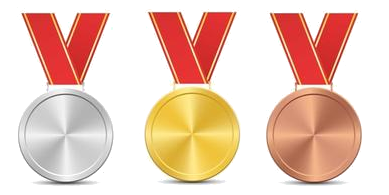 Sport
Sport
 (F)UEFA Nations League
(F)UEFA Nations League
 UEFA Nations League
UEFA Nations League
 UEFA Nations League D- Group 3
UEFA Nations League D- Group 3
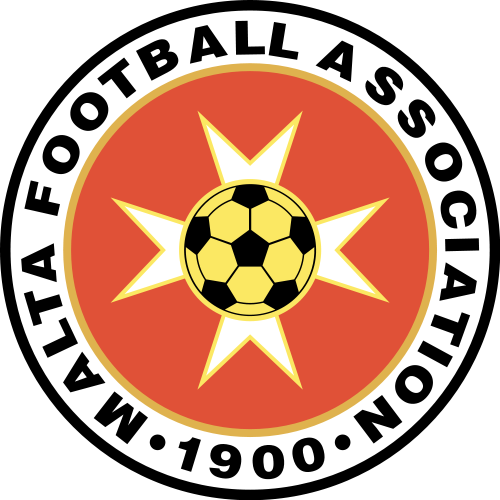
 UEFA European Championship 2020
UEFA European Championship 2020
 Group G
Group G
 Nordmazedonien
Nordmazedonien

 Sport
Sport
 (F)UEFA Nations League
(F)UEFA Nations League
 UEFA Nations League
UEFA Nations League
 UEFA Nations League D- Group 4
UEFA Nations League D- Group 4
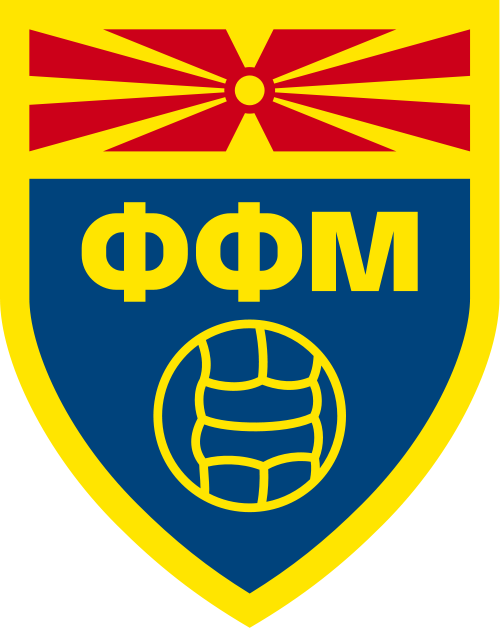
 UEFA European Championship 2020
UEFA European Championship 2020
 Group H
Group H
 Moldawien
Moldawien

 Sport
Sport
 (F)UEFA Nations League
(F)UEFA Nations League
 UEFA Nations League
UEFA Nations League
 UEFA Nations League D- Group 2
UEFA Nations League D- Group 2
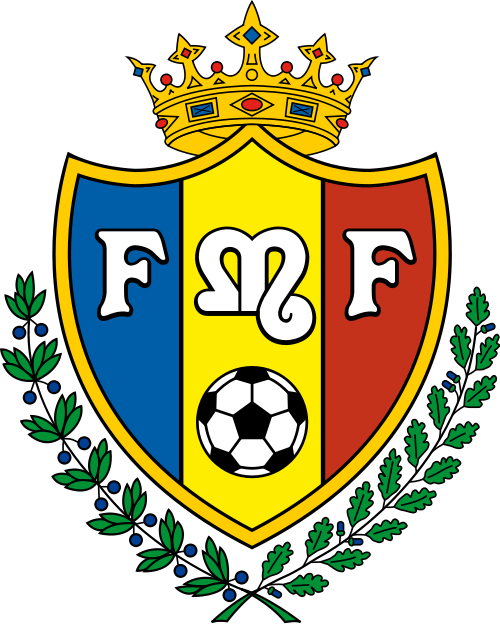

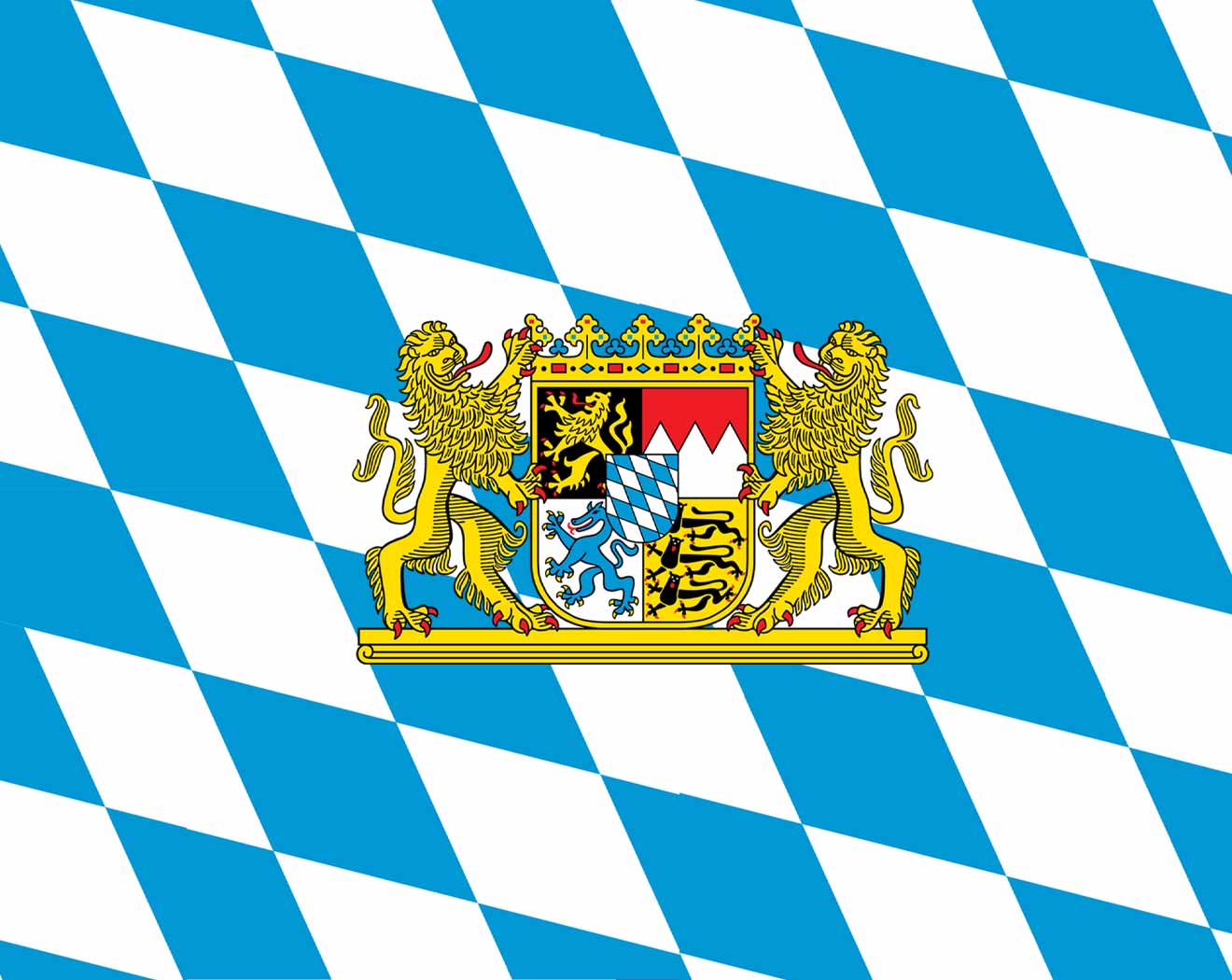 Bavaria
Bavaria
 Germany
Germany
 Eurovision Song Contest,ESC
Eurovision Song Contest,ESC
 FIFA Fussball-Weltmeisterschaft 2006
FIFA Fussball-Weltmeisterschaft 2006
 UEFA European Championship 2020
UEFA European Championship 2020

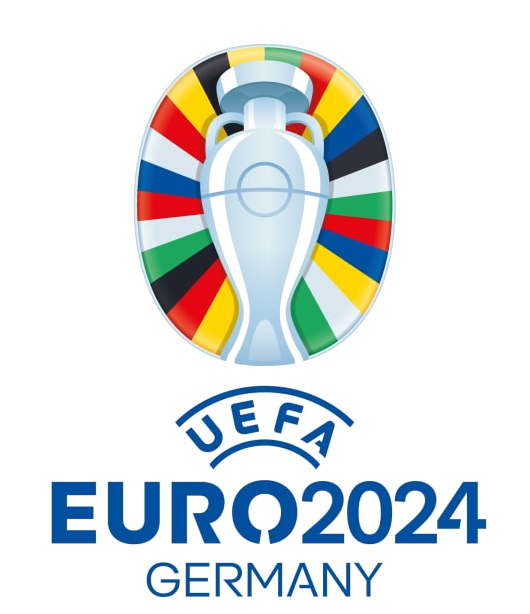 UEFA European Championship 2024
UEFA European Championship 2024

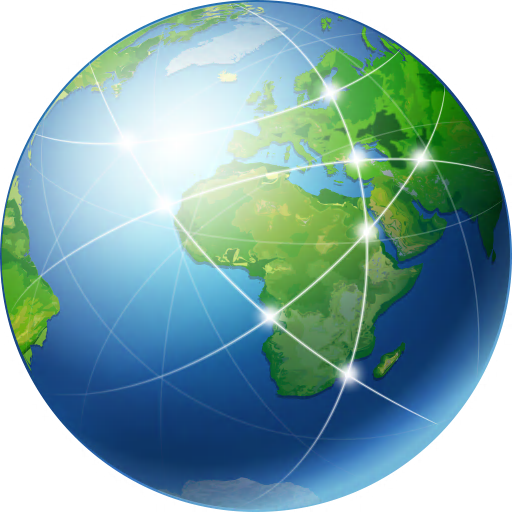 Geography
Geography

 Geography
Geography
 *World's Most Livable Cities
*World's Most Livable Cities

 History
History
 M 1500 - 2000 AD
M 1500 - 2000 AD

 History
History
 L 1000 - 1500 AD
L 1000 - 1500 AD

 History
History
 N 2000 - 2100 AD
N 2000 - 2100 AD

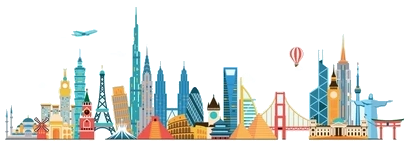 International cities
International cities
 ***Global Urban Economic Competitiveness
***Global Urban Economic Competitiveness
 Olympic Summer Games
Olympic Summer Games
 1972 Summer Olympics
1972 Summer Olympics
 Silk road
Silk road
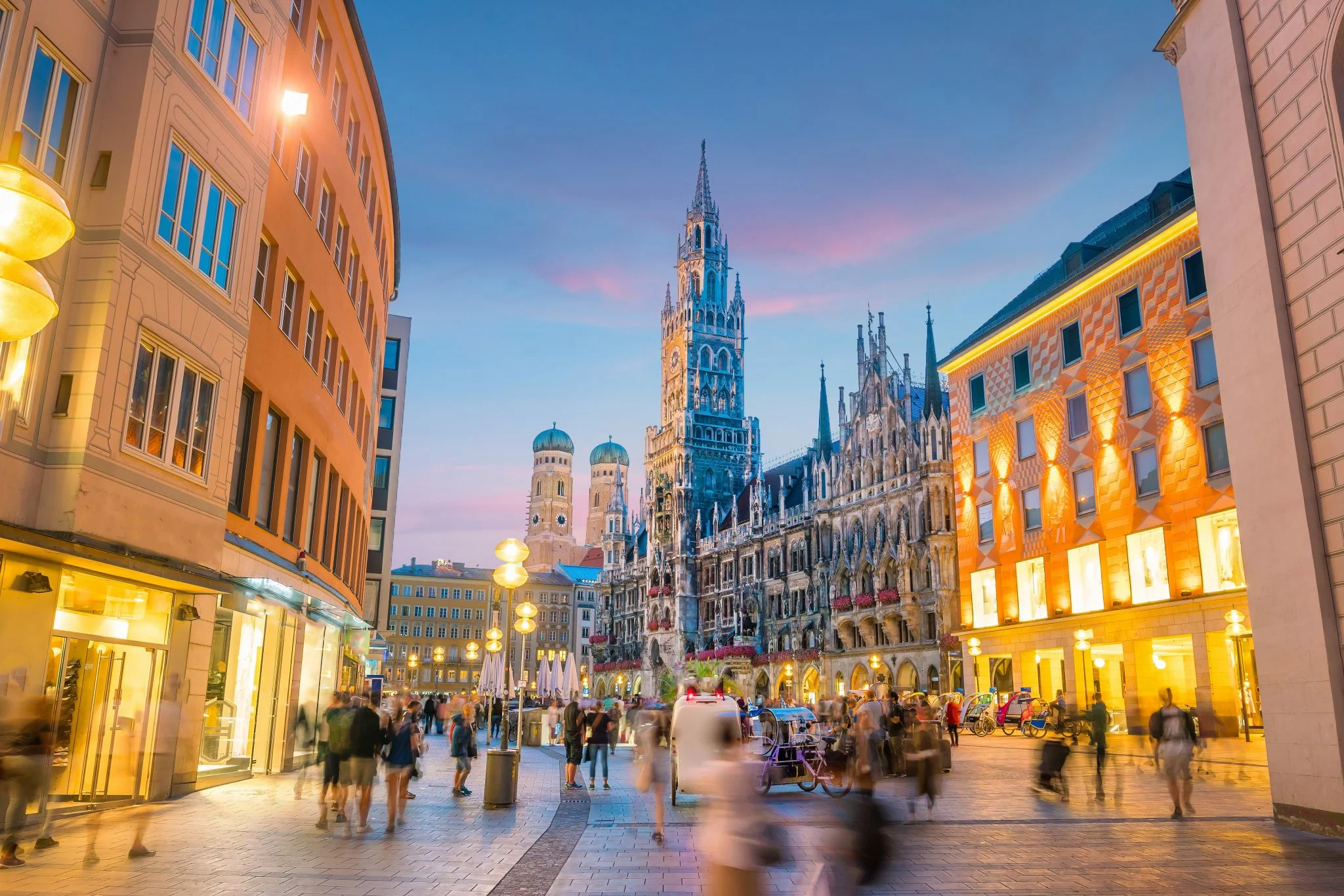
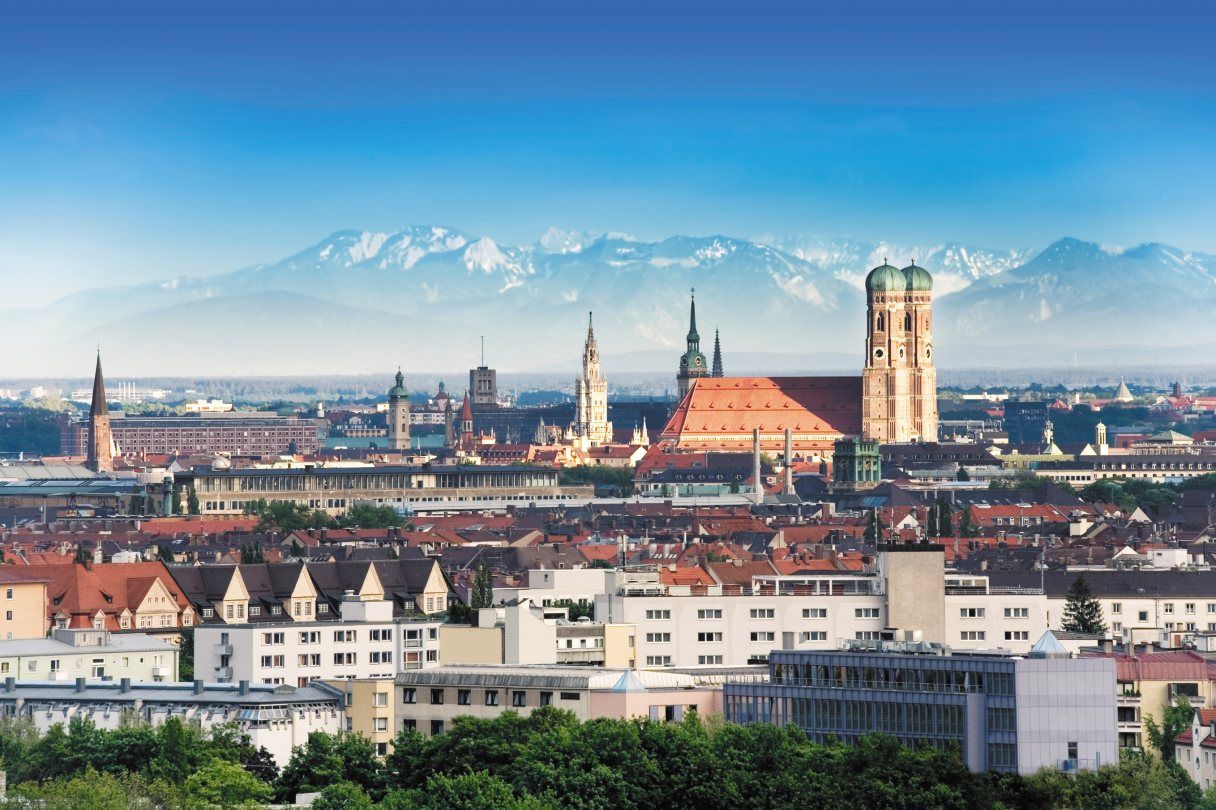
München (hochdeutsch  [ˈmʏnçn̩] oder [ˈmʏnçən̩];[4] bairisch
[ˈmʏnçn̩] oder [ˈmʏnçən̩];[4] bairisch  Minga?/i [ˈmɪŋ(:)ɐ]) ist die Landeshauptstadt des Freistaates Bayern. Sie ist mit rund 1,5 Millionen Einwohnern die einwohnerstärkste Stadt Bayerns und (nach Berlin und Hamburg) die nach Einwohnern drittgrößte Gemeinde Deutschlands sowie die viertgrößte Stadt im deutschsprachigen Raum und zwölftgrößte der Europäischen Union. Im Ballungsraum München leben mehr als 2,9 Millionen Menschen,[5][6] die flächengrößere europäische Metropolregion München umfasst rund 5,7 Millionen Einwohner.
Minga?/i [ˈmɪŋ(:)ɐ]) ist die Landeshauptstadt des Freistaates Bayern. Sie ist mit rund 1,5 Millionen Einwohnern die einwohnerstärkste Stadt Bayerns und (nach Berlin und Hamburg) die nach Einwohnern drittgrößte Gemeinde Deutschlands sowie die viertgrößte Stadt im deutschsprachigen Raum und zwölftgrößte der Europäischen Union. Im Ballungsraum München leben mehr als 2,9 Millionen Menschen,[5][6] die flächengrößere europäische Metropolregion München umfasst rund 5,7 Millionen Einwohner.
Die Landeshauptstadt ist eine kreisfreie Stadt und bayerische Metropole,[7] zudem Verwaltungssitz des die Stadt umgebenden gleichnamigen Landkreises mit dem Landratsamt München als Verwaltung, des Bezirks Oberbayern und des Regierungsbezirks Oberbayern.
München wird zu den Weltstädten gezählt.[8] Die Metropole ist eine der wirtschaftlich erfolgreichsten und am schnellsten wachsenden Europas. Sie ist Sitz zahlreicher Konzerne, darunter fünf DAX-Unternehmen (Allianz, BMW, Linde, Munich Re, Siemens). Hier befindet sich die einzige Börse Bayerns. In der Städteplatzierung des Beratungsunternehmens Mercer belegte München im Jahr 2018 unter 231 Großstädten weltweit den dritten Platz nach Lebensqualität.[9] Laut dem Magazin Monocle war es 2018 sogar die lebenswerteste Stadt der Welt.[10] Andererseits wird die Lebensqualität zunehmend durch Agglomerationsnachteile, wie Verkehrs- und Umweltbelastung sowie sehr hohe Wohneigentumspreise und Mieten[11][12] eingeschränkt, weshalb auch die Wohnfläche pro Einwohner weit unter dem Bundesdurchschnitt liegt.[13] München gilt als sicherste Kommune unter den deutschen Großstädten über 200.000 Einwohnern hinsichtlich der Kriminalitätsrate aller Straftaten.[14]
München wurde 1158 erstmals urkundlich erwähnt.[15] Die Stadt wurde 1255 bayerischer Herzogssitz, war von 1328 bis 1347 kaiserliche Residenzstadt und wurde 1506 alleinige Hauptstadt Bayerns. München ist Sitz zahlreicher nationaler und internationaler Behörden sowie wichtiger Universitäten und Hochschulen, bedeutender Museen und Theater. Durch eine große Anzahl sehenswerter Bauten samt geschützten Baudenkmälern und Ensembles, internationaler Sportveranstaltungen, Messen und Kongresse sowie das weltbekannte Oktoberfest ist München ein Anziehungspunkt für den internationalen Tourismus.
In der Städteplatzierung des Beratungsunternehmens Mercer belegte München im Jahr 2012 unter fünfzig Großstädten weltweit nach Infrastruktur den zweiten und nach Lebensqualität den vierten Platz.
慕尼黑位于德国南部阿尔卑斯山北麓的伊萨尔河畔,是德国南部第一大城,全德国第三大城市,仅次于首都柏林与北部最大城市汉堡。是德国主要的经济、文化、科技和交通中心之一,也是欧洲最繁荣的城市之一。慕尼黑同时又保留着原巴伐利亚王国都城的古朴风情,被人们称作“百万人的村庄”,是生物工程学、软件及服务业的中心。拥有各大公司的总部和许多跨国公司的欧洲总部。
慕尼黑是德国第二大金融中心(仅次于法兰克福),慕尼黑是欧洲最大的出版中心,拥有德国最大的日报之一《南德意志报》,以及许多出版社(仅次于纽约市)。
慕尼黑(德语:München)是德国巴伐利亚州的首府。慕尼黑分为老城与新城两部分,总面积达310平方千米。它是德国南部第一大城,全德国第三大城市,排在柏林与汉堡之后,总人口约130万,有“百万人的村落”的美称。慕尼黑位于德国南部,是巴伐利亚州的文化中心兼首府。它享有“欧洲建筑博物馆”的美誉,哥特式、古罗马式、巴洛克式古建筑以及各式现代化的建筑比比皆是,圣母教堂、路德维希大街是这座城市不可遗忘的部分。自中世纪起,慕尼黑就以啤酒而闻名。是世界第三大啤酒生产地。一年一度的啤酒节让整个城市都沉浸在欢乐的气氛中。这里还是高科技产业中心,宝马、西门子等世界性的大企业总公司就设在慕尼黑。慕尼黑工科大学的科研开发堪称世界一流 。
ミュンヘン(ドイツ語: München, ドイツ語発音: [ˈmʏnçən] (![]() 音声ファイル)[2], バイエルン語: Minga)は、イーザル川河畔にありバイエルンアルプスの北側に位置する都市。ドイツの連邦州であるバイエルン州最大の都市であり、同州の州都でもある。
音声ファイル)[2], バイエルン語: Minga)は、イーザル川河畔にありバイエルンアルプスの北側に位置する都市。ドイツの連邦州であるバイエルン州最大の都市であり、同州の州都でもある。
ミュンヘン(標準ドイツ語:München, バイエルン語:Minga〔ミンガ〕、ミュンヘン方言:Münchn〔ミュンヒン〕)という名は僧院という意味で、ドイツ語で僧を表す「メンヒ」に由来する。漢字表記は「民顕」。"che" の部分の無声硬口蓋摩擦音 [ç] の音写を表すために、[hə]/[xə] の発音を示す「ヘ」ではなく、[çə] の発音を示す「ヒェ」を用い、「ミュンヒェン」とも表記される(こちらのほうがドイツ語の発音に近い)。また "Mü" の発音は正確には「ミュ」ではなく、[mʏ] であり、[ʊ] の形に唇を開き、[ɪ] と発音した音に近い。同じ上部ドイツ語に属するアレマン語では、Münche(ミュンヒェ/ミュンキェ)と発音される。英語やフランス語では Munich(英語:ミューニック[mjú:nik]/仏語:ミュニク[mynik])、イタリア語では Monaco(モナコ公国との区別のために、「バイエルンの」という意味の語をつけてMonaco di Baviera, モナコ・ディ・バヴィエラ)と呼ばれる。
ミュンヘンはベルリン、ハンブルクに次いでドイツでは3番目に大きな都市で、市域人口は140万人近くに達する。1972年にミュンヘンオリンピックが開催された。
ミュンヘンの標語は「ミュンヘンはあなたを愛している。」 "München mag Dich" だが、2006年以前は "Weltstadt mit Herz" 「心を持つ国際都市」であった。ミュンヘンの市章には地名の由来となった僧が表現され、黒と金の配色の市旗は神聖ローマ帝国の色で市の公式の色としてルートヴィヒ4世の時代以来使われている。
今日のミュンヘンは金融、出版の中心都市でたびたび、移住者などが住むのに適した場所として上位に位置付けられる。2011年のマーサー・ヒューマン・リソース・コンサルティングによる世界で最も居住に適した都市では4位を獲得した[3]。2010年のライフスタイルマガジンMonocleの調査では5位に付けており、未だにドイツの都市の中では高い位置にある[4]。経済的、社会的革新に関する162の指標の分析を基にした調査では2thinknowイノベーション都市指数で289都市中、世界では15位、ドイツ国内では5位に付けた[5]。
Munich (/ˈmjuːnɪk/; German: München [ˈmʏnçn̩] ( listen);[2] Austro-Bavarian: Minga [ˈmɪŋ(ː)ɐ]) is the capital and the most populated city in the German state of Bavaria, on the banks of the River Isar north of the Bavarian Alps. Munich is also the third largest city in Germany, after Berlin and Hamburg, and the 12th largest city in the European Union, with a population of around 1.5 million.[3] The Munich Metropolitan Region is home to 6 million people.[4]
listen);[2] Austro-Bavarian: Minga [ˈmɪŋ(ː)ɐ]) is the capital and the most populated city in the German state of Bavaria, on the banks of the River Isar north of the Bavarian Alps. Munich is also the third largest city in Germany, after Berlin and Hamburg, and the 12th largest city in the European Union, with a population of around 1.5 million.[3] The Munich Metropolitan Region is home to 6 million people.[4]
The city is a major centre of art, technology, finance, publishing, culture, innovation, education, business, and tourism in Germany and Europe and enjoys a very high standard and quality of living, reaching first in Germany and third worldwide according to the 2018 Mercer survey,[5] and being rated the world's most liveable city by the Monocle's Quality of Life Survey 2018.[6] According to the Globalization and World Rankings Research Institute Munich is considered an alpha-world city, as of 2015.[7]
The name of the city is derived from the Old/Middle High German term Munichen, meaning "by the monks". It derives from the monks of the Benedictine order, who ran a monastery at the place that was later to become the Old Town of Munich; hence the monk depicted on the city's coat of arms. Munich was first mentioned in 1158. Catholic Munich strongly resisted the Counter-Reformation and was a political point of divergence during the resulting Thirty Years' War, but remained physically untouched despite an occupation by the Protestant Swedes.[8][citation needed] Once Bavaria was established as a sovereign kingdom in 1806, it became a major European centre of arts, architecture, culture and science. In 1918, during the German Revolution, the ruling house of Wittelsbach, which had governed Bavaria since 1180, was forced to abdicate in Munich and a short-lived socialist republic was declared.
In the 1920s, Munich became home to several political factions, among them the NSDAP. The first attempt of the Nazi movement to take over the German government in 1923 with the Beer Hall Putsch was stopped by the Bavarian police in Munich with gunfire. After the Nazis' rise to power, Munich was declared their "Capital of the Movement". During World War II, Munich was heavily bombed and more than 50% of the entire city and up to 90% of the historic centre were destroyed. After the end of postwar American occupation in 1949, there was a great increase in population and economic power during the years of Wirtschaftswunder, or "economic miracle". Unlike many other German cities which were heavily bombed, Munich restored most of its traditional cityscape and hosted the 1972 Summer Olympics. The 1980s brought strong economic growth, high-tech industries and scientific institutions, and population growth. The city is home to major corporations like BMW, Siemens, MAN, Linde, Allianz and MunichRE.
Munich is home to many universities, museums and theatres. Its numerous architectural attractions, sports events, exhibitions and its annual Oktoberfest attract considerable tourism.[9] Munich is one of the most prosperous and fastest growing cities in Germany. It is a top-ranked destination for migration and expatriate location, despite being the municipality with the highest population density in Germany (4,500 people per km²) . Munich hosts more than 530,000 people of foreign background, making up 37.7% of its population.[10]
Munich (/my.nik/) (München en allemand, prononcé : [ˈmʏnçən] Écouter ; Minga en bavarois) est une ville du sud de l'Allemagne et la capitale du Land de Bavière. Avec 1 548 319 habitants intra-muros au 30 juin 20171 et 2 351 706 habitants dans son aire urbaine2, elle est la troisième ville d'Allemagne par la population après Berlin et Hambourg. La Région métropolitaine de Munich, qui englobe également Augsbourg et Ingolstadt, compte quant à elle plus de cinq millions d'habitants. Traversée par l'Isar, affluent du Danube, elle se situe dans le district de Haute-Bavière, au pied des Alpes bavaroises.
Le nom de la ville provient du vieux haut-allemand Munichen (« par les moines »), en raison de la présence d'un monastère bénédictin à l'emplacement actuel de la vieille ville ; l'héraldique fait par ailleurs figurer un moine. Mentionnée pour la première fois en 1158, Munich devient la ville de résidence des ducs de Bavière en 1255 et de l'empereur romain germanique Louis IV. En 1506, après deux siècles de division, les principautés s'unifient pour former la Bavière. Ville catholique - ce dont témoigne la cathédrale Notre-Dame, principal édifice religieux de la ville -, elle est l'un des foyers de la Contre-Réforme. Devenue capitale de l'électorat de Bavière (1623) puis du royaume de Bavière (1805), elle devient un des principaux centres culturels, artistiques et scientifiques allemands au XIXe siècle, sous l'impulsion du roi Louis II.
Au cours du XXe siècle, Munich connaît un important développement industriel, devenant le premier pôle économique de la République fédérale allemande (1949-1990) puis de l'Allemagne réunifiée. Elle accueille notamment le siège de grandes sociétés comme Siemens, Allianz, BMW, Münchener Rückversicherung, Linde, Airbus Deutschland et HypoVereinsbank. Selon Eurostat, la zone urbaine élargie de la région métropolitaine de Munich est la plus importante d'Allemagne en termes de PIB avec 117,6 milliards d'euros, devant Hambourg, Berlin et Francfort. Avec un PIB par habitant de 53 073 euros, Munich est également l'une des villes les plus riches de l'Union européenne2.
Deuxième destination touristique d'Allemagne après Berlin, Munich est célèbre pour sa traditionnelle fête de la bière, l'Oktoberfest, qui se déroule chaque année de fin septembre à début octobre. Outre la cathédrale, la ville a également un important patrimoine historique, composé notamment du château de Nymphenbourg, de très nombreux musées richement dotés et de deux vastes jardins, le Hofgarten et le Englischer Garten (jardin anglais). Réputée être l'une des villes les plus agréables à vivre au monde, Munich accueille de nombreux évènements internationaux, dont les Jeux olympiques d'été de 1972, qui furent le théâtre d'une sanglante prise d'otages. Enfin, elle est le lieu de résidence de l'un des principaux clubs de football d'Europe, le Bayern Munich, qui joue dans l'Allianz Arena, au nord du centre-ville.
Monaco di Baviera (/ˈmɔnako di baˈvjɛra/; in tedesco: München, /ˈmʏnçən/, ascolta[?·info]; in bavarese: Minga) è una città extracircondariale della Germania meridionale, capitale (Landeshauptstadt) della Baviera. Situata sulle rive del fiume Isar, dopo Berlino ed Amburgo è la terza città tedesca per numero di abitanti[2], con una popolazione di circa 1 528 849 (30-04-2016) residenti nel comune,[3] 1 808 550 se si considera anche il circondario di Monaco e circa 2,7 milioni nell'area metropolitana.
È la città più importante della Germania meridionale, grazie alle residenze reali, agli immensi parchi, ai suoi musei, alle sue chiese barocche e rococò, al folclore bavarese ancora molto vissuto, alla vicinanza delle Prealpi e delle Alpi e naturalmente grazie alla birra ed alla sua manifestazione più famosa, l'Oktoberfest. Il santo patrono della città è San Benno di Meißen. Nel 2015[4] uno studio della società di consulenza globale Mercer ha classificato Monaco di Baviera al quarto posto tra le 20 città del mondo con la miglior qualità della vita; nel 2016[5] la città mantiene la sua posizione.
Múnich2 (AFI: ['mu.nitʃ], también [ˈmu.nik];3 en alemán, München,  [ˈmʏnçən] (?·i); en austro-bávaro: Minga [ˈmɪŋ(ː)ɐ]) es la capital, la mayor y la más importante ciudad del estado federado de Baviera y,4 después de Berlín y Hamburgo, la tercera ciudad de Alemania por número de habitantes. Se encuentra sobre el río Isar, al norte de los Alpes Bávaros.
[ˈmʏnçən] (?·i); en austro-bávaro: Minga [ˈmɪŋ(ː)ɐ]) es la capital, la mayor y la más importante ciudad del estado federado de Baviera y,4 después de Berlín y Hamburgo, la tercera ciudad de Alemania por número de habitantes. Se encuentra sobre el río Isar, al norte de los Alpes Bávaros.
El lema de la ciudad es München mag Dich (A Múnich le gustas). Antes de 2006 era Weltstadt mit Herz (Ciudad cosmopolita con corazón). Su nombre, München, deriva de Munichen, del alto alemán antiguo, que significa «en el lugar de los monjes». El nombre de la ciudad viene de los monjes benedictinos que fundaron la ciudad; de ahí que en el escudo de la ciudad haya un monje. Los colores oficiales de la ciudad son el negro y el oro, colores del Sacro Imperio Romano Germánico, desde tiempos de Luis IV de Baviera.
El área metropolitana de Múnich incluye algunas localidades colindantes de esta ciudad. Según un estudio de 2009, Múnich es la ciudad con la mejor calidad de vida de Alemania.5
El Múnich moderno es un centro financiero y editorial. En cuanto a innovación social y económica, la ciudad se encuentra en el 15.º lugar entre 289 ciudades según un estudio de 2010, y es la quinta ciudad alemana para el 2thinknow Innovation Cities Index basado en un análisis de 162 indicadores.6
El exónimo en español de la ciudad, que posee la particularidad de contar con una «ch» final, algo ajeno al sistema fonológico español, nace de los exónimos en francés e inglés. Por tanto, la pronunciación del exónimo es, etimológicamente, [ˈmunik], a través de la pronunciación del exónimo en inglés, o ['munitʃ], siguiendo las normas de pronunciación habituales del español. El gentilicio es «muniqués» y su plural, «muniqueses». El Diccionario Panhispánico de Dudas desaconseja la pronunciación con diptongo [ˈmiunik], propia del inglés.7 Múnich fue sede de los Juegos Olímpicos de 1972.
Мю́нхен (нем. München [ˈmʏnçən], бав. Minga, лат. Monacum, Monachium) — город на реке Изаре, на юге Германии, в федеральной земле Бавария. Внерайонный город (нем. kreisfreie Stadt), одновременно являющийся административным центром Баварии и административного округа Верхняя Бавария.
Название города произошло от древневерхненемецкого Munichen — «у монахов».
Население Мюнхена — 1 542 886 человек (31 октября 2016)[6]. Таким образом, он является крупнейшим городом Баварии и третьим, после Берлина и Гамбурга, городом Германии. В Мюнхене находится правительство Баварии, правительство округа Верхняя Бавария, а также правительство мюнхенского городского округа.
Мюнхен славится своими пивоваренными традициями. В городе находятся шесть крупных пивоварен, которые снабжают пивом знаменитый на весь мир Октоберфест — праздник пива, кренделей, жареных курочек и каруселей, ежегодно проводящийся в конце сентября — начале октября на Терезином лугу.
Современный Мюнхен — не только сосредоточие культурных и музейных ценностей, но и крупный промышленный и исследовательский центр. Благодаря знаменитым университетам, одной из крупнейших в Европе Баварской государственной библиотеке, насчитывающей шесть миллионов томов, институтам имени Макса Планка и имени Хайнца Майера-Лейбница, ядерному научно-исследовательскому реактору и многим другим учреждениям Мюнхен удерживает прочные позиции в европейской науке. Также Мюнхен по праву считается ИТ-столицей Германии. Недвижимость в Мюнхене самая дорогая в Германии.[7]
 UEFA European Championship 2020
UEFA European Championship 2020
 Group F
Group F
 Norwegen
Norwegen

 Sport
Sport
 (F)UEFA Nations League
(F)UEFA Nations League
 UEFA Nations League
UEFA Nations League
 UEFA Nations League C - Group 3
UEFA Nations League C - Group 3


 FIFA
FIFA
 UEFA European Championship 2016
UEFA European Championship 2016
 UEFA European Championship 2020
UEFA European Championship 2020

 UEFA European Championship 2024
UEFA European Championship 2024
 Switzerland
Switzerland

 Sport
Sport
 (F)International soccer leagues
(F)International soccer leagues

 Sport
Sport
 (F)European football championship
(F)European football championship

 Sport
Sport
 (F)UEFA Women's Champions League
(F)UEFA Women's Champions League

 Sport
Sport
 (F)UEFA Youth League
(F)UEFA Youth League

 Sport
Sport
 (F)UEFA Futsal Cup
(F)UEFA Futsal Cup

 Sport
Sport
 (F)UEFA Nations League
(F)UEFA Nations League
 UEFA Champions League 2015/16
UEFA Champions League 2015/16
 UEFA Champions League 2016/17
UEFA Champions League 2016/17
 UEFA Champions League 2017/18
UEFA Champions League 2017/18
 UEFA Champions League 2018/19
UEFA Champions League 2018/19
 UEFA Champions League 2019/20
UEFA Champions League 2019/20
 UEFA Europa League 2017/18
UEFA Europa League 2017/18
 UEFA Europa League 2018/19
UEFA Europa League 2018/19
 UEFA Europa League 2019/20
UEFA Europa League 2019/20
 Union of European Football Associations
Union of European Football Associations
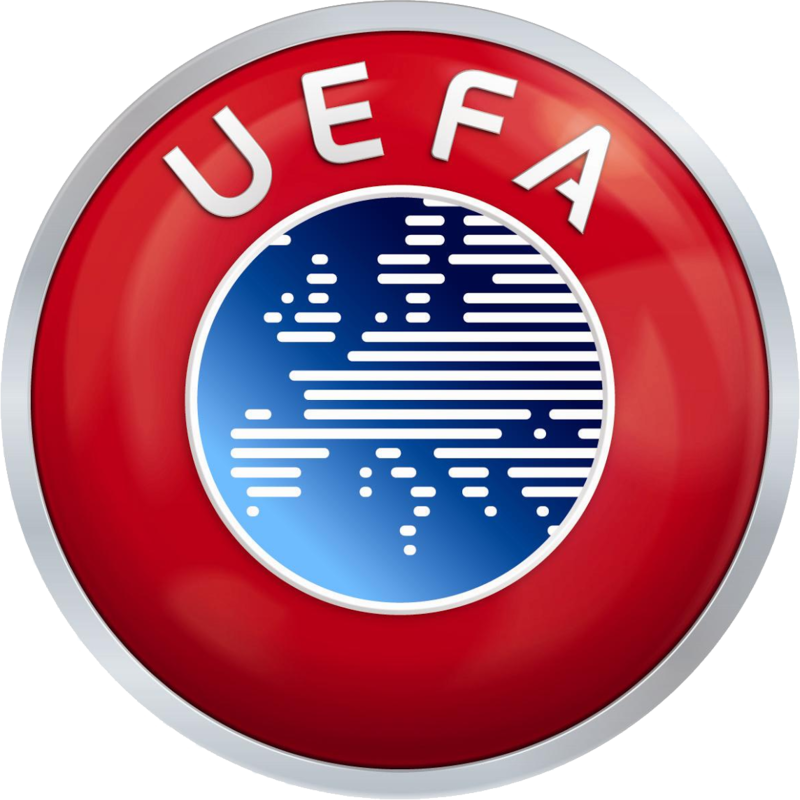
Die Union of European Football Associations (offiziell französisch Union des Associations Européennes de Football[1] [ˈɥɛfa]; deutsch Union Europäischer Fußballverbände [uˈeːfa] genannt), kurz UEFA [juːˈeɪfə], ist der europäische Fußballverband. Die UEFA ist ein gemeinnütziger Verein[2][3][4] im Sinne der Artikel 60 ff.[5] des Schweizerischen Zivilgesetzbuches[6] und im Handelsregister eingetragen.
Die UEFA ist eine der sechs Kontinental-Konföderationen des Weltfußballverbandes FIFA und umfasst 55 nationale Fußballverbände einzelner Länder und Gebiete, die nicht alle innerhalb der geografischen Grenzen Europas liegen.
欧洲足球联合会联盟(英语:Union of European Football Associations,首字母缩写为UEFA),官方简称欧洲足联或欧足联,港澳地区简称欧洲足协,台湾简称欧洲足总[3][4],是负责管理欧洲区各项足球事务,并代表欧洲的足球机构(包括所有的欧洲国家以及俄罗斯、土耳其、以色列、格鲁吉亚、亚美尼亚、阿塞拜疆、塞浦路斯和哈萨克等亚洲或跨欧亚两洲的国家)。
欧足联是国际足联底下六个洲别足球联会之一。由于世界上许多顶尖球员因为欧洲五大足球联赛(英超、西甲、德甲、意甲、法甲)的高竞技水平和高薪和而齐聚于欧洲,使得欧足联在世界上的影响力高居六大足联之首。世界上许多足球强国也均是欧足联的成员国,在2006年世界杯32强中,有14支国家队来自欧洲,在国际足联世界排名中,也有13个国家排在前20名。
欧洲足联于1954年6月15日在瑞士巴塞尔成立,成立时总部设于法国巴黎,1959年移往瑞士伯尔尼。埃贝·施瓦泽(Ebbe Schwartz)成为第一任欧洲足联主席,而欧洲足球锦标赛创办人亨利·德劳内(Henri Delaunay)则为秘书长。1995年总部移至瑞士尼永。成立之初只有25个成员协会,目前欧洲足联已有55个成员协会。现任主席是亚历山大·切费林(Aleksander Čeferin)。
欧州サッカー連盟(おうしゅうサッカーれんめい、英: Union of European Football Associations、仏: Union des associations européennes de football[4][5])は、ヨーロッパの各国・地域サッカー協会を統括する、国際サッカー連盟(FIFA)傘下のサッカーの大陸連盟である。
頭字語(略称)のUEFA(日本語発音:ウエファ、英語発音: [juːˈeifə] ユーエイファ)で呼ばれることが多い。
UEFAは、イタリア、フランス、ベルギー協会間での協議の後、1954年6月15日にスイスのバーゼルで設立された。当初は、25の協会からなっていたが、1990年代初めまでに加盟協会は倍に増加した。ヨーロッパの全ての主権国の協会がUEFAの会員となっているわけではないが、非会員の国家は全てミニ国家である。以前はアジアサッカー連盟(AFC)に加盟していたいくつかのアジアの国も、政治的理由などによりUEFAへの加盟が認められている(イスラエル(政治的理由)とカザフスタンはAFCから転籍した)。
UEFA本部は1959年までは、フランスのパリに位置し、後にスイスのベルンに移転。1995年から、同じくスイスのニヨンへ移転した。
The Union of European Football Associations (UEFA /juːˈeɪfə/ yoo-AY-fə; French: Union des Associations Européennes de Football;[a] German: Vereinigung Europäischer Fußballverbände)[b] is the administrative body for association football, futsal and beach soccer in Europe, although several member states are primarily or entirely located in Asia. It is one of six continental confederations of world football's governing body FIFA. UEFA consists of 55 national association members.
UEFA represents the national football associations of Europe, runs nation and club competitions including the UEFA European Championship, UEFA Nations League, UEFA Champions League, UEFA Europa League, and UEFA Super Cup, and controls the prize money, regulations, and media rights to those competitions.
Henri Delaunay was the first general secretary and Ebbe Schwartz the first president. The current president is Aleksander Čeferin, a former Football Association of Slovenia president, who was elected as UEFA's seventh president at the 12th Extraordinary UEFA Congress in Athens in September 2016, and automatically became a vice-president of the world body FIFA.[3]
L'Union des associations européennes de football, plus connue sous son sigle UEFA (correspondant à son nom en anglais Union of European Football Associations, parfois traduit en « Union européenne de Football-Association ») est une association regroupant et représentant les fédérations nationales de football d'Europe.
Fondée en 1954, l'UEFA a pour rôle de gérer et développer le football à l'échelon continental, sous l'égide de la FIFA. Elle organise et administre les principales compétitions continentales, qu'elles soient destinées aux sélections, comme le Championnat d'Europe et la Ligue des nations, ou aux clubs, comme la Ligue des champions, la Ligue Europa et la Supercoupe de l'UEFA. Elle est aussi responsable des compétitions de football féminin.
L'UEFA rassemble 55 fédérations depuis l'admission du Kosovo en 2016. Basée en Suisse depuis 1959, c'est une association au sens du droit suisse, neutre sur le plan politique et religieux. Son président actuel est le juriste slovène Aleksander Čeferin, élu le 14 septembre 2016 après l'intérim de onze mois de l'ancien footballeur espagnol Ángel María Villar Llona qui remplaçait alors Michel Platini, suspendu par la Commission d'éthique de la FIFA.
La Union of European Football Associations (in italiano: Unione delle associazioni calcistiche europee, in francese: Union des associations européennes de football),[1] meglio nota con l'acronimo di UEFA, è l'organo amministrativo, organizzativo e di controllo del calcio europeo con sede a Nyon (Svizzera).
La Unión de Asociaciones Europeas de Fútbol1 (en francés, Union des Associations Européennes de Football),2 referida comúnmente por su acrónimo UEFA, es la confederación europea de asociaciones nacionales de fútbol y máximo ente de este deporte en el continente. Agrupa en la actualidad a 55 asociaciones y es una de las seis confederaciones pertenecientes a la Federación Internacional de Fútbol Asociación (FIFA), máximo rector en el mundo.3
Fundada el 15 de junio de 1954, su sede central se encuentra en Nyon, Suiza, y es la encargada de organizar los distintos campeonatos de naciones de Europa, además de promover, desarrollar, controlar y velar por el fútbol, sus cometidos, finanzas, reglamentos y medios del mismo, siendo la Eurocopa, oficialmente Campeonato de Europa de Naciones, su principal torneo masculino, y la Eurocopa Femenina, oficialmente Campeonato de Europa Femenino, su homólogo de mujeres. De igual modo es quien trata las diferentes cuestiones de las federaciones nacionales del territorio europeo, así como su fútbol de formación organizando también competiciones para dichas categorías conformando un total de 15 torneos entre todas las disciplinas.4
Es la asociación continental más laureada del ámbito FIFA pues suma entre todas las selecciones de sus miembros un total de 223 títulos oficiales, donde destacan 41 títulos mundiales, además de ser la más reconocida.n 1 Entre ellas destaca Alemania (DFB),5 que es de ser la más galardonada de Europa con 34 títulos; España (RFEF), que es su miembro más premiado en el continente con 29 títulos6n 2; y Francia (FFF), que es la vigente campeona del mundo y la más condecorada en competiciones mundiales con seis trofeos.7
La principal competición en lo que se refiere a los clubes es la Liga de Campeones, tanto en categoría masculina —disputada por primera vez en 1955—, como en femenina —establecida en 2001—. En ellas dominan los clubes españoles con 18 títulos y los alemanes con 9 respectivamente.
Es la tercera confederación continental más antigua, y la que más miembros posee siendo el último en incorporarse la Federación de Fútbol de Kosovo (FFK) —como estado parcialmente reconocido internacionalmente— el 3 de mayo de 2016.8
Сою́з европе́йских футбо́льных ассоциа́ций (англ. Union of European Football Associations, сокращённо UEFA, в русской транслитерации УЕФА) — спортивная организация, управляющая футболом в Европе и некоторых западных регионах Азии. Она объединяет национальные футбольные ассоциации европейских стран и организует все европейские соревнования футбольных клубов и сборных команд, а также распределяет доходы от рекламы и трансляций между клубами и национальными ассоциациями, входящими в её состав.
УЕФА — одна из шести континентальных конфедераций, входящих в Международную федерацию футбола (ФИФА), причём УЕФА из них наиболее влиятельна и богата. Почти все сильнейшие футболисты мира играют в Европе из-за того, что именно в ней самые большие зарплаты, особенно в Англии, Франции, Италии, Испании и Германии[1]. Также УЕФА представляют многие сильные сборные мира, что предопределяет большое представительство стран этой конфедерации на мировых первенствах: так, из 32 команд на чемпионате мира 2006 года УЕФА представляли 14.
УЕФА был основан 15 июня 1954 года в Базеле (Швейцария) после консультаций, начатых федерациями футбола Франции, Италии и Бельгии. Первоначально УЕФА насчитывал 25 стран, сейчас их 55. Штаб-квартира УЕФА располагалась в Париже до 1959 года, когда она переехала в Берн. С 1995 года она базируется в швейцарском Ньоне. Первым генеральным секретарём УЕФА был Анри Делоне, а президентом — Эббе Шварц.
УЕФА часто имел конфликты с Еврокомиссией, организовывавшей интересы национальных ассоциаций. В 1990-х годах разногласия касались прав на телетрансляции и особенно трансферного регламента (правило Босмана).
 Denmark
Denmark
 Germany
Germany
 Germany
Germany
 Germany
Germany
 France
France
 France
France
 UEFA European Championship 2016
UEFA European Championship 2016
 UEFA European Championship 2020
UEFA European Championship 2020

 UEFA European Championship 2024
UEFA European Championship 2024
 Greece
Greece
 Italy
Italy
 Netherlands
Netherlands
 Portugal
Portugal
 Russia
Russia
 Slovakia
Slovakia
 Spain
Spain
 Spain
Spain
 Spain
Spain

 Sport
Sport
 (F)European football championship
(F)European football championship
 Czech Republic
Czech Republic
 Union of European Football Associations
Union of European Football Associations

Der Henri-Delaunay-Pokal (französisch Coupe Henri Delaunay) ist die Gewinntrophäe der Fußball-Europameisterschaft, die seit 1960 verliehen wird.
Der versilberte EM-Pokal wurde 1960 in Paris von Pierre Delaunay entworfen und vom Goldschmied Adrien Chobillon angefertigt,[1] der seinerseits für den französischen Pokal verantwortlich zeichnete. Er ist etwa zehn Kilogramm schwer und hat eine Höhe von 42,5 Zentimetern. Benannt wurde er nach dem Franzosen Henri Delaunay, dem ersten UEFA-Generalsekretär und „geistigem Vater“ der Fußball-Europameisterschaft.
Die EM-Trophäe bleibt als Wanderpokal in ständigem Eigentum der UEFA. Sollte eine Mannschaft dreimal in Folge oder fünfmal insgesamt Europameister werden, erhält der entsprechende Verband eine originalgetreue Nachbildung der Trophäe vom europäischen Fußballverband.

Heimspielbetrieb
FC Kopenhagen
Veranstaltungen
Spiele der dänischen Fußballnationalmannschaft
Finale des dänischen Fußball-Pokals (von 1955 bis 1990, seit 1993)
Finale im Europapokal der Pokalsieger 1993/94
Finale im UEFA-Pokal 1999/2000
Eurovision Song Contest 2001
Lauf zur Speedway-Einzel-Weltmeisterschaft seit 2003
Royal Copenhagen Tennis-Cup 2002
Finale der dänischen Casting-Show The X Factor 2010
Monstertruck-Rennen 2010 (Monster Jam)
Volleyball-Europameisterschaft der Männer 2013
Fußball-Europameisterschaft 2021
Konzerte
Boxkämpfe
 FIFA Fussball-Weltmeisterschaft 2014
FIFA Fussball-Weltmeisterschaft 2014
 FIFA Fussball-Weltmeisterschaft 2018
FIFA Fussball-Weltmeisterschaft 2018
 Group B
Group B
 FIFA Fussball-Weltmeisterschaft 2022
FIFA Fussball-Weltmeisterschaft 2022
 FIFA Fussball-Weltmeisterschaft 2022
FIFA Fussball-Weltmeisterschaft 2022
 Group H
Group H
 FIFA-Konföderationen-Pokal 2017
FIFA-Konföderationen-Pokal 2017
 UEFA European Championship 2016
UEFA European Championship 2016
 UEFA European Championship 2020
UEFA European Championship 2020
 Group B
Group B

 UEFA European Championship 2024
UEFA European Championship 2024
 Luiz Felipe Scolari
Luiz Felipe Scolari
 Portugal
Portugal

 Sport
Sport
 (F)FIFA Confederations Cup
(F)FIFA Confederations Cup

 Sport
Sport
 (F)UEFA Nations League
(F)UEFA Nations League
 UEFA Nations League
UEFA Nations League
 UEFA Nations League A - Group 3
UEFA Nations League A - Group 3

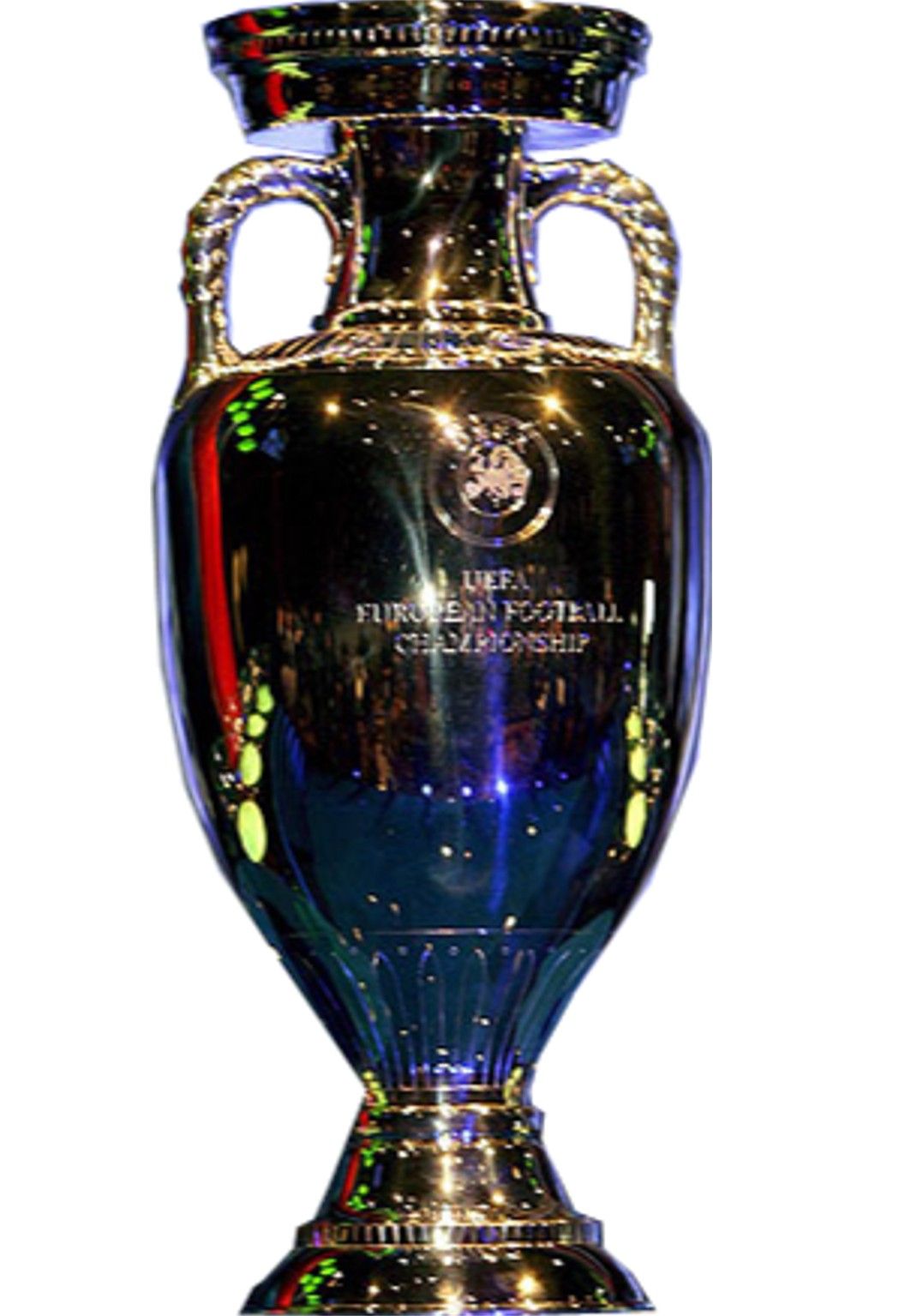



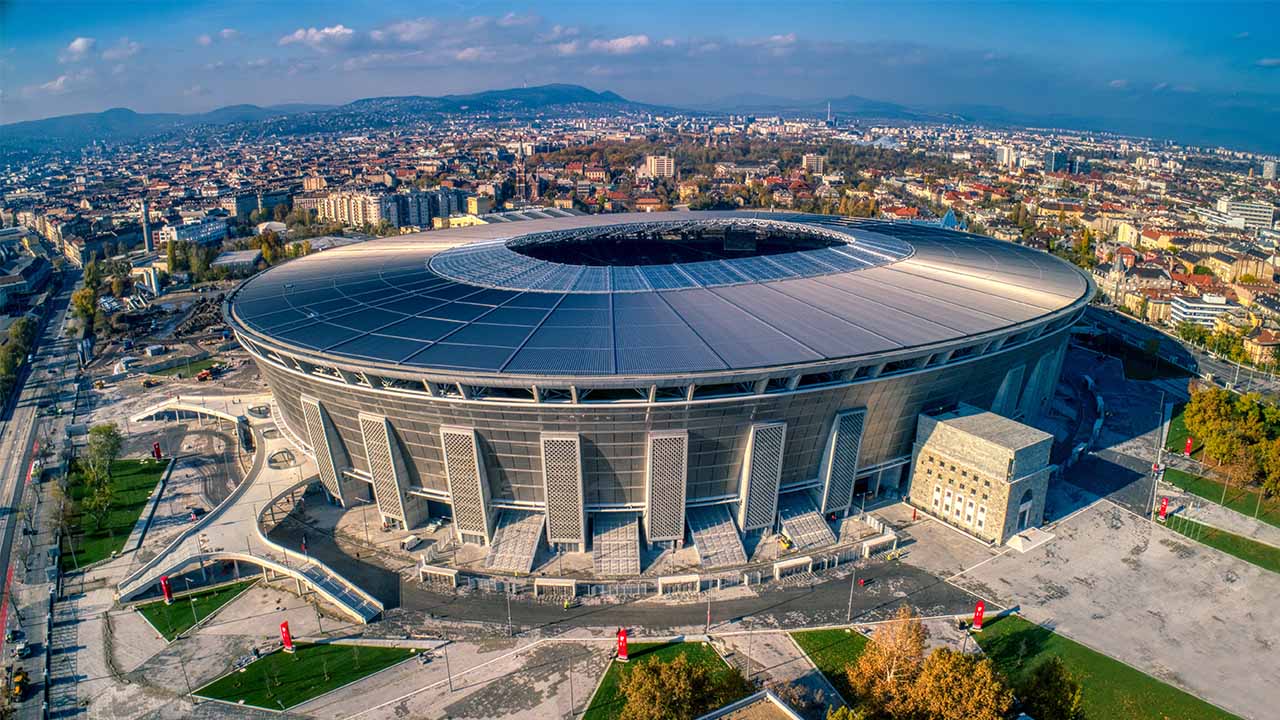
 Architecture
Architecture
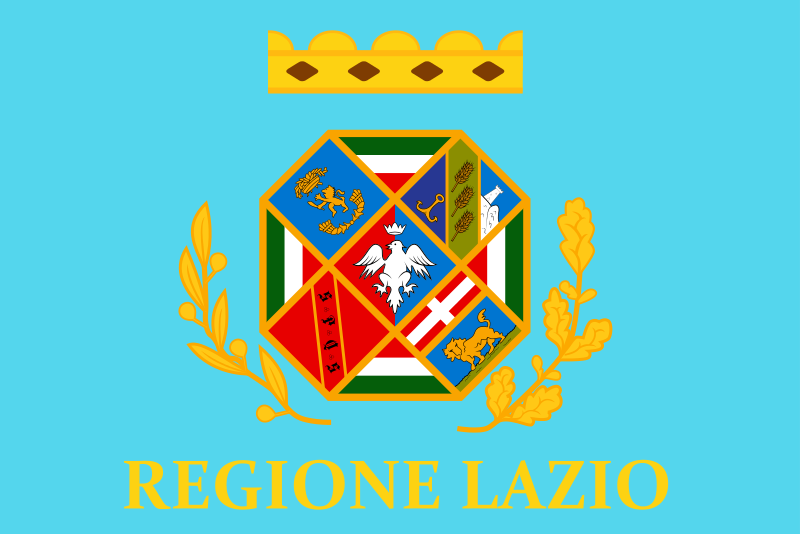 Lazio
Lazio